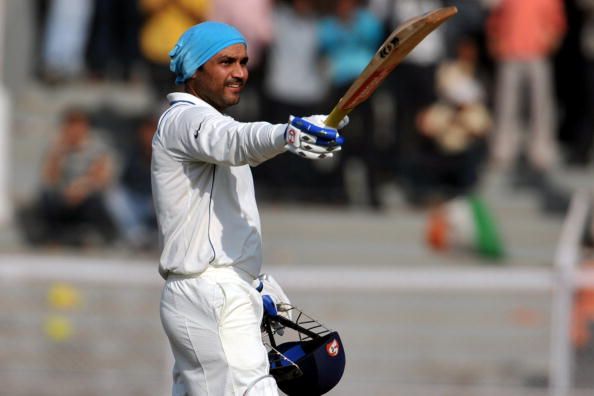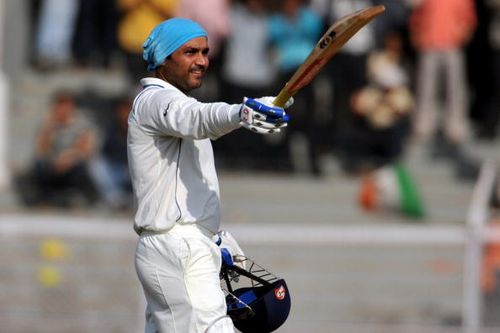
Virender Sehwag: Shattering cricket's utopian world

The boring monotony of utopia
A utopian world is one where the convoluted cogs of machinery run smooth – where everyone impassively, monotonously, vacuously does what they’re meant to do. A cab driver nonchalantly drives the lady with an infatuation for shopping around, the lady devotedly runs the house for her businessman, the businessman strives to make optimum gains every month. The leaders honestly lead the country and the country lovingly harbours its citizens.
In a utopian cricketing world, every team would comprise of batsmen who play the placid, steady anchoring role and bowlers who meticulously stick to the fabled good length for deliveries. You know, where everyone nudges and pokes and prods and manages to get a decent score and every bowler maintains an unblemished economy rate with a couple of wickets. Everyone's in form, everyone's performing and everything's undisputedly, mind-numbingly boring.
Thankfully and unfortunately, given the dynamic human capacity for transgressing monotony, we are prone to experimentation, adaptation and evolution – which slays the looming boredom but ends up, imperceptibly, nurturing vices.
What would we do without the oddballs that shake things up every now and then?
The nifty cab driver looks to extricate surplus money off longer, winding routes, the lady hires a maid so she can exert her energy in bargaining at Joy Alukkas instead, the businessman indulges in shady networks, the leaders orchestrate those shady networks and our beloved country stops loving us.
It all adds to the dark thrill of life, doesn't it?
Such odd individuals exist in cricket as well – ones who scoff at the idea of low-risk cricket. The same ones who hit the big shots knowing well that they're risking their oh-so-precious wicket or ones who attempt to bowl vicious toe-crunching yorkers that might easily end up being full length deliveries that can be dispatched to replace ice cubes in a joyful spectator's beer mug and earn him some transient YouTube fame.
These anomalies (rebels, some would say) bring the high potency of disappointment, the rush, risk, adrenaline and ultimately, the thrill.
A docile batsman like Rahul Dravid or a stringent bowler like Glenn McGrath has his own merits – a colossal quantity of them. People who get their thrills through relishing such styles of cricket aren't wrong. They're right in their own beautiful understanding of cricket. It's just much different from the new generation's (or rather, my own) rebellious representation of fanaticism.
Sehwag: The Trump Card
Virender Sehwag is not the first ruthlessly aggressive batsman in the history of cricket, but he is definitely one of the most accomplished. Many aggressive players came, and many aggressive players fizzled out. Those that remained chose to tone down their raging instincts a bit, and developed gaming gears they could switch into according to the match situation. Sehwag, however, knew just one pure form of play: aggression.
Say there was a cricketer who worked on evasive probability. He would perform once out of every 15 innings, but that performance would be a guaranteed match-winner. If you were the all powerful creator of a cricket team, would you sacrifice a spot for this trump card that is, in essence, a roll of dice for a certain victory in lieu of a consistent cricketer who you know can rack up a lot more runs but might not be successful in the final outcome?
Sehwag was that dicey trump card. Almost every time he scored a century, India walked away with winners' smiles. It wasn't just the centuries though, his vicious 50s and 70s and short fiery knocks of 30s and 40s during large chases helped boost the team's confidence, made the targets seem humanly achievable and even dented the opposition's smugness.
Play into Sunil Narine or Lasith Malinga's hands by attempting to weather their infernal spells and they keep pelting you with their brutal best. Walk out and annihilate their strategy, and they do nothing but flash wide toothy grins as the ball sails to the boundary. Of course, not every batsman can challenge the best, but that's a risk for a psychological advantage that is too underrated in cricket these days.
Always living on the edge, always undertaking risk
Sehwag knew no situation and knew no bowler's credentials. His eyes lit up, while his feet stayed, at any loose delivery. He liked to seal milestones with sixes, and memories with a mark. He focused on hitting the first ball of every match in the 2011 World Cup for a boundary, not giving an ounce of deference for any team’s frontline seamer.
This ode to a legend, one who defined my cricket and bred a fan in me, can be taken as a rueful lamentation, of sorts. For while I mourn his gaping absence from the team, I don’t blame anyone – for a player who toyed with extremes, it was inevitable that he would end up a victim of his adopted style.
Liking Sehwag, or even being a die-hard fan (like I was) was usually a self-inflicted punishment – you would be disappointed more often than you can count. You would sit and wait for every match, get a cheap thrill every time he got off to a quick start and then drown in sorrow as he gave up his wicket. The throbbing excitement would fade, the lustrous thrill would drown and you would settle down into watching Team India build their innings with safer, less adventurous hands.
It was a risk I willingly took, for the insurmountable joy it brought to my love-struck eyes when the Nawab of Najafgarh finally unleashed his wrath in that fifteenth innings and single-handedly determined everyone's fate.
It was a risk I took, because despite the whims and fancies of utopia, I'm after all human and a stickler for cheap thrills.